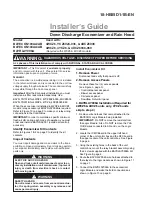
8
❖
English
L-2028 Installation
block. This connection must be made per ABYC specifica-
tions. All pumps, metallic valves and fittings in the seawater
circuit that are isolated from the air conditioning unit by PVC
or rubber hoses must be individually bonded to the boat’s
bonding system also. This will help eliminate any possibility of
corrosion due to stray current.
Note: Failure to properly ground and bond the system will
void the warranty!
Electrical System and Wiring for DC Powered
Cuddy dc
Dometic recommends a separate set of batteries dedicated
for the Cuddy dc air conditioning system. Deep cycle AGM or
Gel Cell batteries are the best for this application. If need be,
please contact your Dometic dealer for assistance in sizing
batteries.
The Cuddy dc kit contains the Dedicated Power Module
(DPM). The DPM is meant to be used for the Cuddy dc
system only and is sized to do so (see Figure 14 at the back
of this manual for DPM specifications).
When connecting the DPM to the batteries, maintain correct
wire size as shown in the DC Wire Sizing Table (see Figure 15
at the back of this manual), keep wire runs as short as
possible, and with as few intermediate connections as
possible, to avoid unnecessary resistance or voltage drop.
See wiring diagram Figure 11 for location of customer-
installed 60 amp fuse. Use an ignition protected fuse holder if
installed in the engine compartment or in any area with
flammable or compressed gasses or liquids (see the Safety
Considerations section of this manual for more information). A
standard ABYC approved battery disconnect switch is also
recommended and should be used any time the system
needs servicing. Do not forget to maintain proper color
coding, (red = positive, black = negative) to aid in future
electrical troubleshooting. If the wires are incorrectly con-
nected (positive and negative reversed), the air conditioning
unit will not start and the DPM will be damaged.
The DPM is wired to the FAN setting on the two-knob switch
assembly and is energized only when the Cuddy dc is
running (see the Operation section of this manual). For DC
wire sizing, see Figure 15 at the back of this manual.
As batteries age, their peak voltage lowers and they dis-
charge quicker. This, of course, can affect the air conditioner
performance as well as other DC devices. The battery
condition should be maintained and monitored regularly and
weak batteries should be replaced. A battery isolator, com-
biner or selector switch will allow simultaneous charging while
preventing the discharge of a fully charged battery into a
depleted one.
Over current protection, in addition to fuse provided, must be
supplied for the ungrounded conductor at the main switch-
board, per ABYC E-9. Use a 60 amp breaker for 12 VDC
systems. This provides protection from possible short circuits.
When dockside, the Cuddy dc unit can operate against the
batteries while using the AC battery charger (50 amp min) as
a backup (most marine battery chargers will shut off when the
battery is fully charged).
Ensure that all DC electrical connections are made in
compliance with American Boat and Yacht Council (ABYC)
standards section E-9.
Notice and ABYC Standards:
Field wiring must comply with ABYC electrical standards.
Power to the unit must be within the operating voltage range
indicated on the data plate. Properly sized fuses and circuit
breakers must be installed for branch circuit protection. See
equipment rating plate for maximum size. All air conditioning
units must be effectively grounded to minimize the hazard of
electric shock and personal injury. The following standards
apply:
1. AC (alternating current) grounding (green) wire must be
provided with the AC power conductors and connected to
the ground terminal (marked “GRND”) at the AC power
input terminal block of the unit(s), per ABYC standard E-8.
2. Connections between the vessel’s AC system grounding
conductor (green wire) and the vessel’s DC (Direct
Current) negative or bonding system should be made as
part of the vessel’s wiring, per ABYC standard E-9.
3. When servicing or replacing existing equipment contain-
ing a chassis-mounted “ground” stud, the service person
or installer must check the vessel’s wiring for the exist-
ence of the connection required in item 2 above.
ABYC standards are available from:
American Boat and Yacht Council
613 Third Street, Suite 10
Annapolis, MD 21403
Phone: (410) 990-4460, Fax: (410) 990-4466
Seawater Pump and Plumbing
Several guidelines should be followed during the installation
of the seawater system. Since the circulation pump is
centrifugal and not self-priming, it must be mounted so that it
is always at least one foot below the water line regardless of
which tack the vessel is on. Pump may be mounted horizon-
tally or vertically, however the discharge must always be
above the inlet. Pump head should be rotated toward the
direction of water flow.
Install the seawater speed scoop
intake as far below the water line and as close to the keel
as possible in any application, but especially on a
sailboat, to keep the intake in the water when the boat
heels over so that air does not get into the system.
The
speed scoop intake must face forward and not be shared with
any other pump. A seawater strainer is mandatory between
Summary of Contents for Cuddy dc
Page 2: ......
Page 22: ...22 English L 2028 Fig 8 Wiring Diagram of ZF3 5 ...
Page 24: ...24 English L 2028 Fig 11 Wiring Diagram for Cuddy dc CD3 5HV 12VDC ...
Page 34: ......
Page 35: ......









































